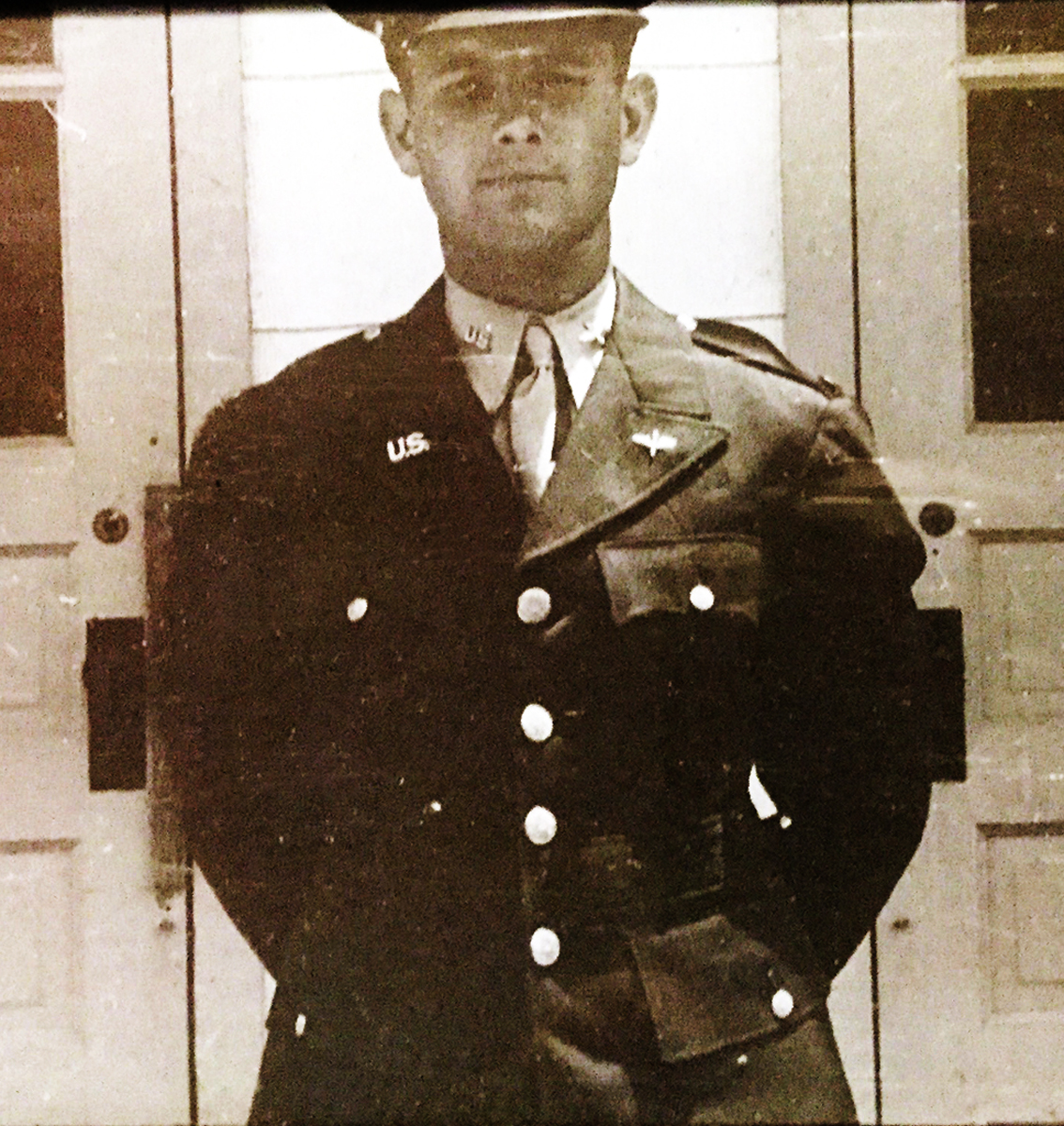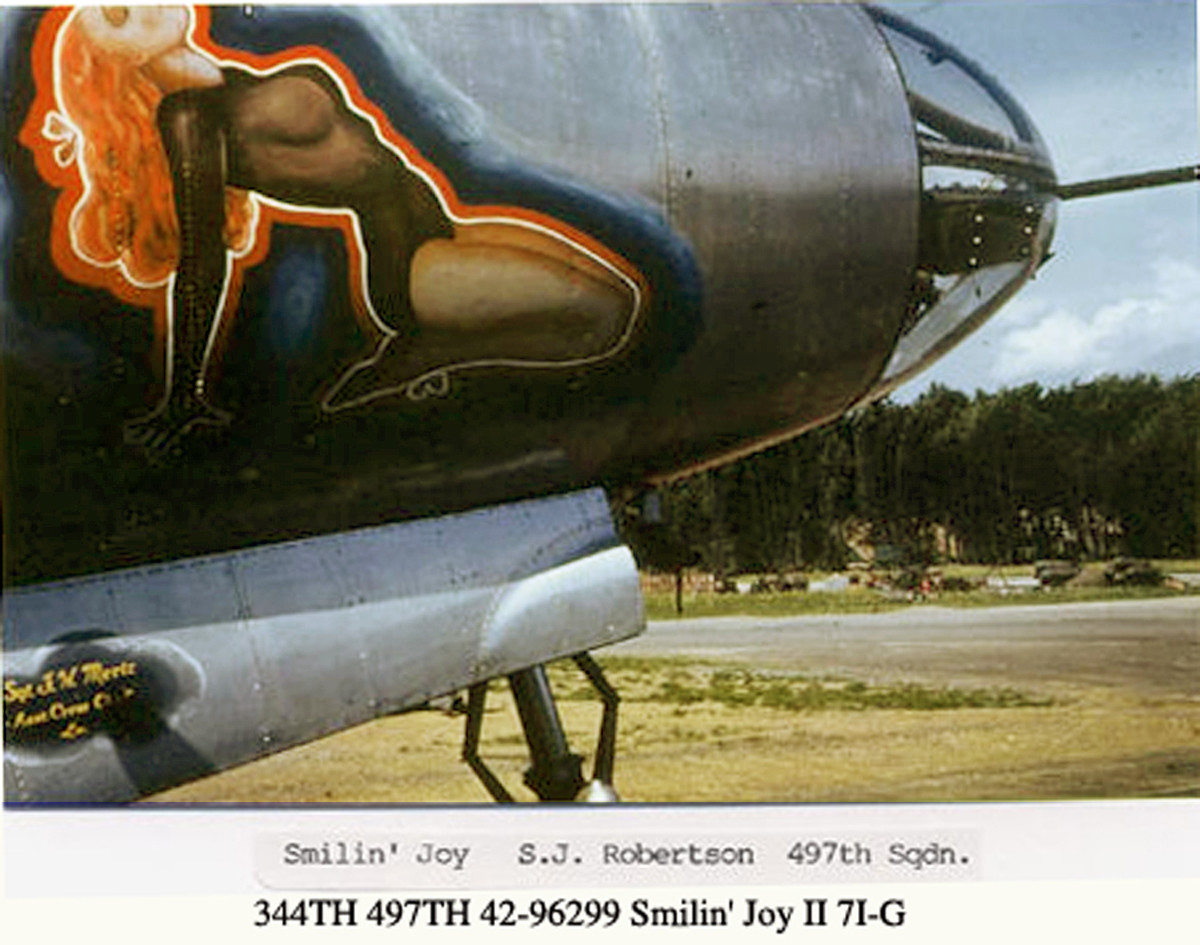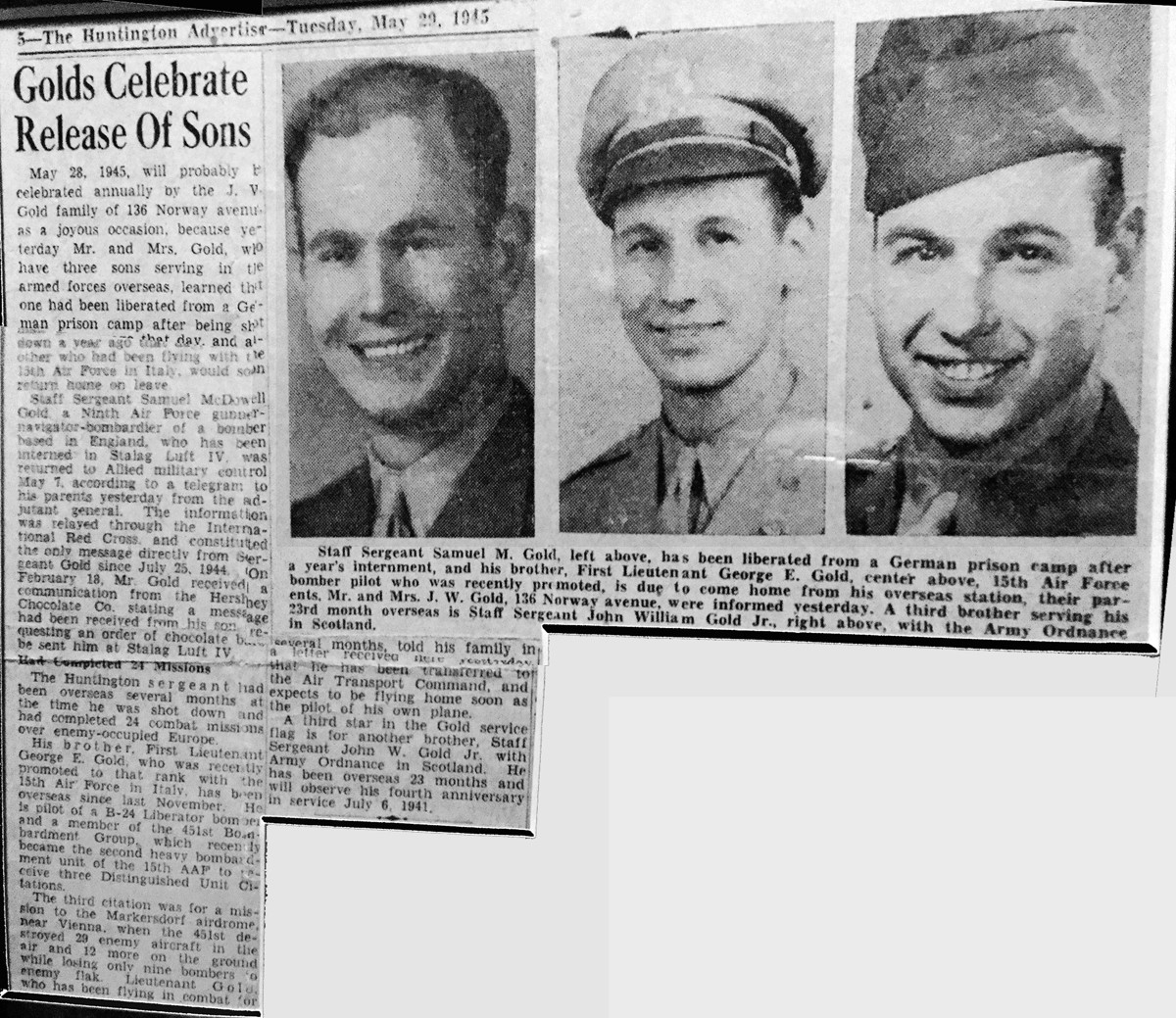S/Sgt. Samuel M. Gold
S/Sgt. Samuel M. Gold was a tail gunner with the 344th Bomb Group 497th Bomb Squadron.
.Click any of the images to see them enlarged.
.S/Sgt. Samuel M. Gold and crew were shot down on May 28, 1944. Gold spent the rest of the war as a prisoner.
.
May 28, 1944 France
Thirty-seven B26 “Marauders” from the 344th BG left their base at Bishop’s Stortford in England on mission number 61: target – the German rail marshalling yards located at Amiens, France. The bomb run was composed of two Boxes of three flights each. Approximate time of take off was 1730. This was the second mission of the day for the 344th bomb group. The morning mission had been over Paris, with several planes lost due to flak.
See a complete official report MACR 5140
All three flights of Box I dropped their bombs from 10,000 feet. Box II was at 11,000 feet, with only Flight 1 and 2 dropping bombs. Flight 3 did not drop their bombs due to evasive action which placed the flight too close to the target.
The bombers were escorted by Ninth Air Force, P-47 fighters. No enemy aircraft were encountered. Enemy flak was described as “moderate accurate”. The flight would officially return at 2059 except for one plane and crew.
On board the B26-B50 “Marauder” #42-95920 (71- L) from the 497th Squadron of the 344th Bomber Group of the 9th Air Force were the following six man crew:
1st Lt. James F. Reynolds pilot
2nd Lt. Edward Horn co-pilot
2nd Lt, James Johnson bombardier
T/Sgt. George H. Coon radio-waist gunner
Cpl. Leonard M. Pew mechanic / top turret gunner*
S/Sgt. Samuel M. Gold tail-gunner*
*The records appear to be at odds with the first hand reports of both Horn and Gold. According to his son, Steve Gold, “According to Ed Horn and Dad, my father was the top turret gunner and Leonard Pew was the Tail gunner. That’s the way I always heard about that mission. Also, in the official mission report I have , Dad is listed as the top turret gunner and Pew as the tail gunner. Dad always said “ the tail gunner did not bail out of the airplane.”
Plane #42-95920 (7I-L) was named “Smilin’ Joy, and was not the normal plane used by this crew.
Plane #42-95902 (7I-G) was named “The Bad Penny”, was being repaired for battle damage. (Note: Plane #42-95902 was flown from West Palm Beach, Florida, by Lts. Reynolds and Horn, and would become the only plane lost during the D-Day bombing mission over Utah Beach.)
2nd Lt. James Johnson had successfully dropped his 8 bombs of 500 pounds each over the rail center of the city of Amiens. The American bombardier, as expected, followed the path of the formation, turning to the left taking a North/Northeast course towards Armentieres.
At approximately 1930 hrs, one of the shells of the German flak, which surrounded for several minutes the entire American formation above Amiens, exploded near the B26 piloted by Lt. Reynolds. The flak burst hit the right side of the bomber, and caused damage to the right engine of the B26. The engine caught fire and the right prop was feathered by the pilots.
In an instant, the plane became unbalanced and dove out of formation. 1st Lt. Reynolds worked rapidly to gain control of his bomber. Holding the joystick with a firm hand, the plane followed its route towards the North, flying a little below the formation and on the left but following a parallel path.
Suddenly, a trail of smoke appeared behind the right engine, with flames soon to follow. Is it possible for the pilots to fly the plane back to England on one engine?
Cpl. Pew, the mechanic, tried to activate the extinguishers with no result. The fire increased on the right engine, putting the entire plane in danger of catching on fire. During this time, the plane continued on it’s flight path. It was now near Doullens, France.
S/Sgt. Anthony Paulino, S/Sgt. Joseph Lovitz. and Sgt. Cleveland Mayfield, watching on board other bombers of the 344th Bomber Group, were officially listed as observing the plane in difficulty.
At this moment the formation was a little south of Pas-en-Artois, preparing to cross the English Channel on its way home to base.
Meanwhile, “Smilin’ Joy”, the B26 “Marauder” with 1st Lt. Reynolds and his crew, was losing altitude. It now began a big curve to the left. At a higher altitude, two P47 “Thunderbolts” accompanied the B26 “Marauder”, which was trailing a plume of smoke behind its right engine.
The curve intensified and the bomber turned toward the South-West still maintaining flight on its single left engine. The plane had now descended to 3000 feet, with the pilots trying to keep the plane in flight in hope of reaching the English Channel.
While 1st Lt. Reynolds tried his best to maintain the burning plane in order to allow his crew to jump, the co-pilot, 2nd Lt. Horn, gave the order to “Bail Out”, and kept an eye on the progress of the evacuation of the bomber.
2nd Lt. Horn was required to slide his co-pilots seat back, in order for 2nd Lt. James Johnson to climb out of his bombardier’s office in the nose. He was the first to jump out of the now opened doors of the bomb bay. Sgts. Gold and Coon also jumped.
After checking with the pilot and doing a final radio check, it was the co-pilot’s turn to jump. 2nd Lt. Edward Horn while making his way back to the bomb bay,noticed flames crawling along the fuel line right behind the cockpit. Lt. Horn jumped, counted to three as taught, and pulled the D-ring of the parachute. He immediately felt a burning along his upper inner thighs as the chute opens and pulls up the straps that he had forgotten to tighten in his haste to jump.
2nd Lt. Horn looked above him to the plane moving away. The pilot was preparing to leave his post when the co-pilot jumped. At this moment a burst of wind caused Lt. Horn’s parachute to whirl resulting in him losing sight of the plane.
The turret-gunner / mechanic Cpl. Pew was still in the plane along with the pilot, Lt. Reynolds. The plane continued to lose altitude, but seemed to still be under control. The right engine was now a shower of flames and the fire reached the fuselage.
Finally, another chute opened. The parachutist seemed to leave the plane by the opening of the front wheel doors. Lt. Reynolds was finally out of the plane. Unfortunately, he was still in danger.
Sgt. Gold would later report the following:
“The Germans were shooting at me with small arms and 20 mm. I saw Lt. Reynolds slump over in his chute as if he was hit. He was about 100 yards from me when this happened. I was hit six times as I was coming down in my chute so I have reason to believe that he was wounded also.”
Sgt. Samuel Gold would successfully reach ground only to be captured at 1930 hrs., at Bienfait, 6 km south of Abbeville, France, by the German Field Guard 3 -35 Komp, Fl. Rgt. 93.
 He would be taken to Dulag Luft for questioning, and later be interred primarily at Stalag Luft IV in Tychowo, Poland, near the Baltic Sea.
He would be taken to Dulag Luft for questioning, and later be interred primarily at Stalag Luft IV in Tychowo, Poland, near the Baltic Sea.
 He survived the war, being liberated in April 1945.
He survived the war, being liberated in April 1945.
On the other hand, 1st Lt. James Foster Reynolds, the pilot, was recovered dead.
The body of the unfortunate pilot was buried in the British military cemetery of Abbeville.
The remains of Lt. Reynolds, USMA Class of 1943, would eventually be transferred to his final resting place in his home state of Texas. He was awarded the Air Medal with Four Oak Clusters and the Purple Heart.
During this time, 2nd Lt. Horn, ending his descent by parachute, had time to notice the huge flames in the distance at some kilometers from where he was.
In fact, the B26 “Marauder” #42-95920 of the 497th Squadron (7I-L) of the 344th Bomber Group, had just ended its career with an enormous explosion in a field near the village de Boengourt and the town of Behen, one km to the South-East of Moyenneville.
It is believed that Cpl. Leonard Pew, the gunner / mechanic, stayed in the plane and his body was found at the crash site. Neverlthless he is still listed as missing-in-action. Cpl. Pew was not a regular member of the crew, and was on his second mission in order to receive extra pay. His name is on the Wall of the Missing at Ardennes American Cemetery, in Neupre, Belgium. He was awarded the Air Medal and a Purple Heart.
2nd Lt. Edward Horn landed near Frucourt, 6 kilometers to the North-West of Oisemont. The American aviator, on his 23rd mission, was taken prisoner and transferred on the 1st of June 1944 near Brussels to a point of prisoner gathering. He would eventually end up in Stalag Luft III, near Sagan, Poland. He was liberated in April, 1945.
2nd Lt. James Johnson, the bombardier, landed unharmed, was found by the French Resistance and was eventually returned to England.
T/Sgt. George Henri Coon, the radio – gunner, landed somewhere to the East of Behen, and was also found by the French Resistance and returned to England.
The official USAAF Missing Aircrew Report would read:
“Plane was hit over target and left formation after going over target, the prop was feathered, the plane turned left off course southwest of Deullens and took a 300 degree course. Plane was escorted by two or more P 47’s. There was no reported observation of plane crashing or of plane reaching friendly territory.”
A fine display of Samuel Gold’s awards
.Sam Gold in his later years.
.









